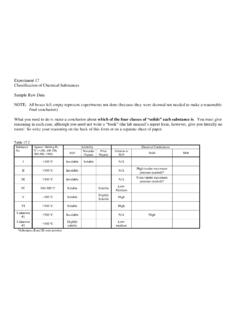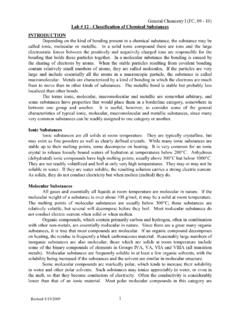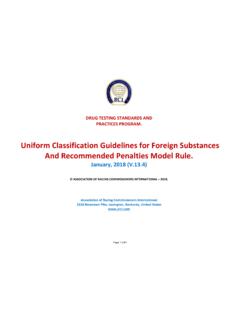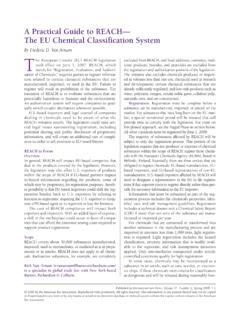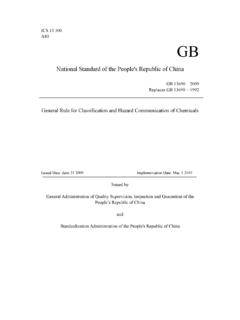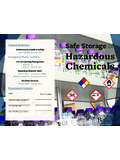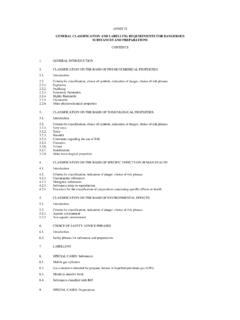Transcription of Chapter 10: CARCINOGENICITY DEFINITIONS
1 Chapter 10: CARCINOGENICITY DEFINITIONS 1. The term "carcinogen" denotes a chemical substance or a mixture of chemical substances which induce cancer or increase its incidence. Substances which have induced benign and malignant tumours in well performed experimental studies on animals are considered also to be presumed or suspected human carcinogens unless there is strong evidence that the mechanism of tumour formation is not relevant for humans. 2. classification of a chemical as posing a carcinogenic hazard is based on the inherent properties of the substance and does not provide information on the level of the human cancer risk which the use of the chemical may represent. CONSIDERATIONS 3. The purpose of the harmonised system for the classification of chemicals which may cause cancer is to provide common ground which could be used internationally for the classification of carcinogenic substances.
2 4. The scheme is applicable to the classification of all chemicals. Its application to classification of mixtures is explained in paragraphs 13-18. classification CRITERIA FOR SUBSTANCES 5. For the purpose of classification for CARCINOGENICITY , chemical substances are allocated to one of two classes based on strength of evidence and additional considerations (weight of evidence). In certain instances route specific classification may be warranted. 2 CATEGORY 1: KNOWN OR PRESUMED HUMAN CARCINOGENS The placing of a chemical in Category 1 is done on the basis of epidemiological and/or animal data. An individual chemical may be further distinguished: CATEGORY 1A: KNOWN to have carcinogenic potential for humans; the placing of a chemical is largely based on human evidence. CATEGORY 1B: PRESUMED to have carcinogenic potential for humans; the placing of a chemical is largely based on animal evidence.
3 Based on strength of evidence together with additional considerations, such evidence may be derived from human studies that establish a causal relationship between human exposure to a chemical and the development of cancer (known human carcinogen). Alternatively, evidence may be derived from animal experiments for which there is sufficient evidence to demonstrate animal CARCINOGENICITY (presumed human carcinogen). In addition, on a case by case basis, scientific judgement may warrant a decision of presumed human CARCINOGENICITY derived from studies showing limited evidence of CARCINOGENICITY in humans together with limited evidence of CARCINOGENICITY in experimental animals. classification : Category 1 (A and B) Carcinogen CATEGORY 2: SUSPECTED HUMAN CARCINOGENS The placing of a chemical in Category 2 is done on the basis of evidence obtained from human and/or animal studies, but which is not sufficiently convincing to place the chemical in Category 1.
4 Based on strength of evidence together with additional considerations, such evidence may be from either limited evidence of CARCINOGENICITY in human studies or from limited evidence of CARCINOGENICITY in animal studies. classification : Category 2 Carcinogen Rationale 6. classification as Carcinogen is made on the basis of evidence from reliable and acceptable methods, and is intended to be used for chemicals which have an intrinsic property to produce such toxic effects. The evaluations should be based on all existing data, peer-reviewed published studies and additional data accepted by regulatory agencies. 7. Carcinogen classification is a one-step, criterion-based process that involves two interrelated determinations: evaluations of strength of evidence and consideration of all other relevant information to place chemicals with human cancer potential into hazard classes.
5 8. Strength of evidence involves the enumeration of tumours in human and animal studies and determination of their level of statistical significance. Sufficient human evidence demonstrates causality between human exposure and the development of cancer, whereas sufficient evidence in animals shows a causal relationship between the agent and an increased incidence of tumours. Limited evidence in humans is demonstrated by a positive association between exposure and cancer, but a causal relationship cannot be stated. Limited evidence in animals is provided when data suggest a carcinogenic effect, but are less than sufficient. The terms "sufficient" and "limited" are used here 3as they have been defined by the International Agency for Research on Cancer (IARC) and are cited in the Background Information for this document. 9. Additional considerations (weight of evidence).
6 Beyond the determination of the strength of evidence for CARCINOGENICITY , a number of other factors should be considered that influence the overall likelihood that an agent may pose a carcinogenic hazard in humans. The full list of factors that influence this determination is very lengthy, but some of the important ones are considered here. 10. The factors can be viewed as either increasing or decreasing the level of concern for human CARCINOGENICITY . The relative emphasis accorded to each factor depends upon the amount and coherence of evidence bearing on each. Generally there is a requirement for more complete information to decrease than to increase the level of concern. Additional considerations should be used in evaluating the tumour findings and the other factors in a case-by-case manner. 11. Some important factors which may be taken into consideration, when assessing the overall level of concern are: Tumour type and background incidence.
7 Multisite responses. Progression of lesions to malignancy. Reduced tumour latency. Additional factors on which the evaluation may increase or decrease the level of concern include: Whether responses are in single or both sexes. Whether responses are in a single species or several species. Structural similarity or not to a chemical (s) for which there is good evidence of CARCINOGENICITY . Routes of exposure. Comparison of absorption, distribution, metabolism and excretion between test animals and humans. The possibility of a confounding effect of excessive toxicity at test doses. Mode of action and its relevance for humans, such as mutagenicity, cytotoxicity with growth stimulation, mitogenesis, immunosuppression. 12. Mutagenicity. It is recognised that genetic events are central in the overall process of cancer development.
8 Therefore evidence of mutagenic activity in vivo may indicate that a chemical has a potential for carcinogenic effects. classification CRITERIA FOR MIXTURES classification of Mixtures When Data are Available for the Complete Mixture. 13. classification of mixtures will be based on the available test data of the individual constituents of the mixture using cut-off values/concentration limits for the components of the mixture. The classification may be modified on a case-by case basis based on the available test data for the mixture as a whole. In such cases, the test results for the mixture as a whole must be shown to be conclusive taking into account dose and other factors such as duration, observations and analysis ( , statistical analysis, test sensitivity) of CARCINOGENICITY test systems. Adequate documentation supporting the classification should be retained and made available for review upon request.
9 4 classification of Mixtures When Data are not Available for the Complete Mixture. Bridging Principles 14. Where the mixture itself has not been tested to determine its carcinogenic hazard, but there are sufficient data on the individual ingredients and similar tested mixtures to adequately characterise the hazards of the mixture, this data will be used in accordance with the following agreed bridging rules. This ensures that the classification process uses the available data to the greatest extent possible in characterising the hazards of the mixture without the necessity for additional testing in animals. Dilution 15. If a mixture is diluted with a diluent which is not expected to affect the CARCINOGENICITY of other ingredients, then the new mixture may be classified as equivalent to the original mixture. Batching 16. The carcinogenic potential of one production batch of a complex mixture can be assumed to be substantially equivalent to that of another production batch of the same commercial product produced by and under the control of the same manufacture unless there is reason to believe there is significant variation in composition such that the carcinogenic potential of the batch has changed.
10 If the latter occurs, a new classification is necessary. Substantially similar mixtures 17. Given the following: a). Two mixtures: i.) A + B ii.) C + B b). The concentration of carcinogen ingredient B is the same in both mixtures. c). The concentration of ingredient A in mixture i equals that of ingredient C in mixture ii. d). Data on toxicity for A and C are available and substantially equivalent, they are not expected to affect the CARCINOGENICITY of B. If mixture (i) is already classified by testing, mixture (ii) can be assigned the same category. classification of Mixtures When Data are Available for All Components or Only for Some Components of the Mixture. 18. The mixture will be classified as a carcinogen when at least one ingredient has been classified as a Category 1 or Category 2 carcinogen and is present at or above the appropriate cut-off value/concentration limit as mentioned in Table 1 below for Category 1 and 2 respectively.










